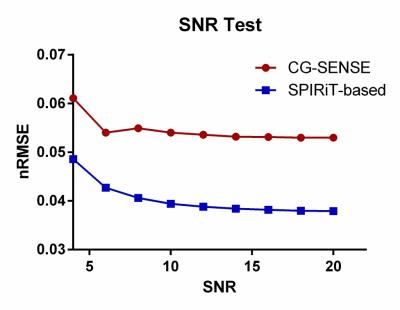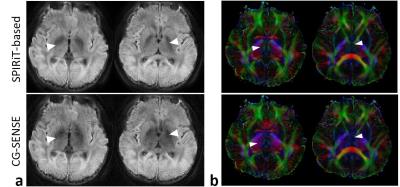3998
High-Resolution DWI Using Multishot Variable Density Spiral with SPIRiT-Based Reconstruction1Center for Biomedical Imaging Research, Department of Biomedical Engineering, School of Medicine, Tsinghua University, Beijing, People's Republic of China, 2Harvard-MIT Health Sciences and Technology, MIT, Cambridge, MA, United States, 3Vascular Imaging Laboratory, Department of Radiology, University of Washington, Seattle, WA, United States
Synopsis
Multishot variable density spiral is an efficient sequence for diffusion imaging with the oversampled k-space center serving as a navigator. However, the shot-to-shot phase variation of multishot acquisition due to motion must be corrected. To improve the reconstruction accuracy, we propose a novel reconstruction framework using SPIRiT-based reconstruction, integrating the information of phase variation and coil sensitivity in order to correct for the ghosting artifacts of multi-shot DWI. Both simulation and in-vivo experiment validated the superior performance of the proposed method to reconstruct more accurate images than CG-SENSE for VDS DWI.
Purpose
Multishot DWI can reduce image distortion and provide higher resolution images than single-shot methods. One of the most efficient multishot acquisition techniques is multishot variable density spiral (VDS) which oversamples central k-space data as self-navigators for phase correction while maintaining a fast k-space traversal speed. Conjugate gradient reconstruction (CG-SENSE) 1 is an effective method to remove strong ghosting artifacts for VDS DWI, by integrating different shots and channels in the image calculation. To further improve the robustness of phase correction and image quality for multishot VDS DWI, we propose a novel reconstruction framework using SPIRiT-based reconstruction 2 method in which better conditioned formulation is achieved by self-consistency constraint.Methods
In multishot diffusion imaging, phase variation among different shots can be regarded as encoding information like coil sensitivity encoding. Thus, multiple shots can be used as virtual coils, and be combined with multi-coil data. SPIRiT is a parallel imaging method which improves the performance of traditional GRAPPA-like methods because the formulation of iteratively enforcing self-consistency is better conditioned 3. Thus, SPIRiT is adopted to diffusion image reconstruction integrating shot and coil dimension to solve an optimization problem given by,$$arg\min_f \lVert Df-d \lVert^2+\lVert (G-I)f \lVert^2 .$$Here, the image domain SPIRiT reconstruction was used to reconstruct the full image $$$f$$$ through all shots and channels. The first term is data fidelity and the second term is self-consistency constraint. $$$D$$$ is a series of non-uniform Fourier Transform operations to transfer the images to k-space data, with same patterns as the sampled VDS k-space data $$$d$$$. $$$G$$$ is a multiplication operator in image domain derived from the calibration process, and $$$I$$$ is the identity matrix.
The flowchart of the proposed method for multishot VDS DWI is shown in Figure 1. The phase variation of different shots for calibration process are obtained from the inherent navigators in VDS. In order to improve the quality of calibration data, a pre-reconstruction for the center of k-space is conducted for each shot respectively using the conventional SPIRiT 3. After reconstruction of k-space center, a low resolution image of each shot and each channel is obtained. Then, the operator $$$G$$$ can be derived from the low resolution images through calibration process. Finally, SPIRiT-based reconstruction is performed to get the images of all shots and channels.
The SPIRiT-based reconstruction was compared with the conventional SPIRiT 3 and CG-SENSE 1. The kernel size of SPIRiT-based reconstruction was 7×7 and the matrix size of calibration data was 20×20.
Simulation A T2 weighted image was used to simulate the multishot VDS data. The k-space data were sampled by 18 shots with an 8-channel RF coil and 2nd-order spatially varying random phases were added to different shots respectively to simulate the motion-induced phase variations. Data with different SNRs (SNR = 4~20) were simulated by adding Gaussian noise in k-space to test the robustness of the proposed method.
In vivo experiments To evaluate the performance of the proposed method, in-vivo experiments were performed on healthy volunteers using multishot VDS with α=4. The data were acquired on a Philips 3T Achieva TX scanner (Philips Healthcare, Best, The Netherlands) using the following parameters: number of shots = 18, number of coils = 8, number of directions = 32, b value = 800 s/mm2, FOV = 220×220 mm2, slice thickness = 5 mm, in-plane resolution = 0.86×0.86 mm2, acquisition matrix = 256×256, TR/TE= 2500/64 ms, NSA = 1.
Results
Figure 2 shows the reconstructed results of the three methods: conventional SPIRiT, CG-SENSE and SPIRiT-based reconstruction with SNR = 10. SPIRiT-based method generated the image more accurately with a lower nRMSE than the other two methods. The comparison of the proposed method and CG-SENSE with different levels of SNR is shown in Figure 3. The nRMSEs of the proposed method are lower than CG-SENSE at all SNR levels, demonstrating the robustness of the proposed method. The in vivo diffusion images of two slices in one representative direction and the corresponding color-coded FA maps are shown in Figure 4. Signal losses occurred in the regions around the ventricle (white arrows, usually with strong phase variations) of diffusion images reconstructed by CG-SENSE. The same region in the corresponding FA maps also has strong blue color. In contrast, SPIRiT-based method performed better with much suppressed artifacts.Discussion and Conclusion
Both simulation and in-vivo experiment validate the advantages of the proposed method for multishot VDS DWI with improved accuracy and reduced artifacts, benefiting from the better conditioned formulation with self-consistency constraint. The proposed method can correct the phase variation of multishot DWI using VDS and provide reliable diffusion images.Acknowledgements
This work was supported by Tsinghua University Initiative Scientific Research Program.References
1. Liu C, Moseley ME, Bammer R. Simultaneous phase correction and SENSE reconstruction for navigated multi-shot DWI with non-cartesian k-space sampling. Magn Reson Med, 2005. 54(6): p. 1412-22.
2. Dong Z, Wang F, Ma X, Dai E, Zhang Z, Guo H. A Robust Reconstruction Method for High Resolution Multishot DWI: SPIRiT-based SYMPHONY. In Proceedings of the 24rd Annual Meeting of ISMRM. 2016. Singapore.
3. Lustig M, Pauly JM. SPIRiT: Iterative self-consistent parallel imaging reconstruction from arbitrary k-space. Magn Reson Med, 2010. 64(2): p. 457-471.
Figures



